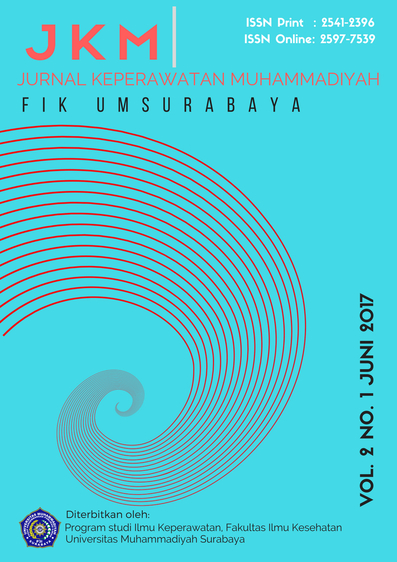Community Capacity: A Concept Analysis
DOI:
https://doi.org/10.30651/jkm.v2i1.1068Abstrak
Objective: Â The purpose of this analysis is to clarify the concept of community capacity by using Walker and Avant's (1995) concept analysis.
Methods: This article based on identification of the concept from various resources included: dictionary, articles, case study.
Results:  Community capacity was the  process or activities which use systematic approach which involve the competence and ability of the community in dealing with and solving the problem and raise into the welfare state of being in multi-sectoral way .
Referensi
Centers for Disease Control and Prevention (U.S.), Healthy Communities Program. (2012). A Sustainability planning guide for healthy communities. National Center for Chronic Disease Prevention and Health Promotion (U.S.), Division of Adult and Community Health.
Chaskin, R. J. (2001). Building Community Capacity. New York: Aldine Transaction.
Community capacity building: Definitions, scope, measurements and critiques | International Association for Community Development. (n.d.). Retrieved September 8, 2014, from http://www.iacdglobal.org/publications-and-resources/iacd-publications/community-capacity-building-definitions-scope-measurements-and-critiques
Condell, S. L., & Begley, C. (2007). Capacity building: a concept analysis of the term applied to research. International Journal of Nursing Practice, 13(5), 268–275. doi:10.1111/j.1440-172X.2007.00637.x
Crisp, B. R., Swerissen, H., & Duckett, S. J. (2000). Four approaches to capacity building in health: consequences for measurement and accountability. Health Promotion International, 15(2), 99–107. doi:10.1093/heapro/15.2.99
Gunawan, A., Post, T. J., Sat, M. | T. A. |, 2012, J. 16, & Am, 7:54. (n.d.). Indonesia has most cases of Dengue Fever in ASEAN. Retrieved September 5, 2014, from http://www.thejakartapost.com/news/2012/06/16/indonesia-has-most-cases-dengue-fever-asean.html
Kurniawati, D. (n.d.). Rising Number of Dengue Fever Cases in Indonesia. Retrieved September 5, 2014, from http://www.establishmentpost.com/rising-number-of-dengue-fever-cases-in-indonesia/
Luke, H. (2014). Dengue Fever on the Rise in Southeast Asia. Retrieved September 3, 2014, from http://thediplomat.com/2014/02/dengue-fever-on-the-rise-in-southeast-asia/
Measuring Community Capacity Building. (n.d.). Retrieved November 11, 2014, from http://www.aspeninstitute.org/publications/measuring-community-capacity-building
M.H, Steinberg (2008) Evidence Review: Communicable Disease (Health Promotion. Population and Public Health, Ministry of Healthy Living and Sport.
Morgan, P. (n.d.). The concept of capacity. Retrieved September 8, 2014, from http://www.seachangecop.org/node/1627
Pai, H.-H., Hong, Y.-J., & Hsu, E.-L. (2006). Impact of a short-term community-based cleanliness campaign on the sources of dengue vectors: an entomological and human behavior study. Journal of Environmental Health, 68(6), 35–39.
Sines, D., Saunders, M., & Forbes-Burford, J. (Eds.). (2009). Community Health Care Nursing (4th Edition edition.). Chichester, U.K: Wiley-Blackwell.
Therawiwat, M., Fungladda, W., Kaewkungwal, J., Imamee, N., & Steckler, A. (2005). Community-based approach for prevention and control of dengue hemorrhagic fever in Kanchanaburi Province, Thailand. The Southeast Asian Journal of Tropical Medicine and Public Health, 36(6), 1439–1449.
Unduhan
Diterbitkan
Terbitan
Bagian
Lisensi
- Penulis tetap memegang hak atas karyanya dan memberikan hak publikasi pertama kepada jurnal ini yang secara simultan karya tersebut dilisensikan di bawah:Â Creative Commons Attribution-ShareAlike 4.0 International (CC BY-SA 4.0)













